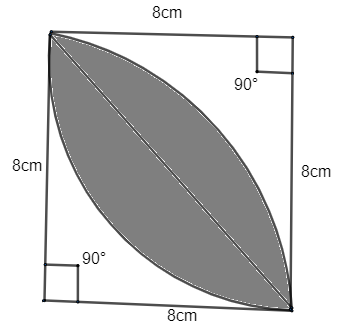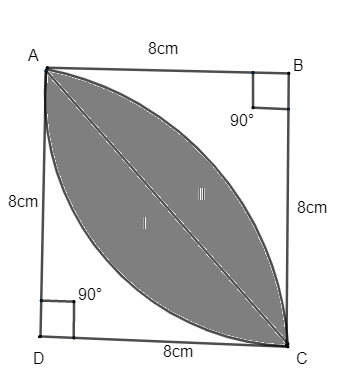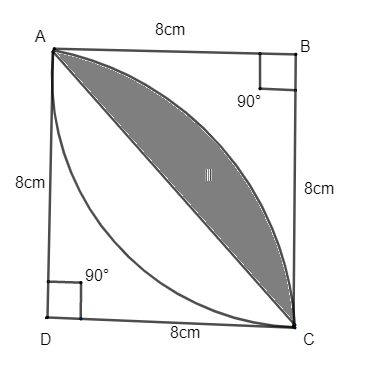
Calculate the area of the designed region in the figure, common between the two quadrants of the circle of radius 8 cm each.


Answer
590.7k+ views
Hint: Given is a square of side 8cm. The area of the designed region can be found by dividing it into \[I\] and \[II\]. Subtract the area of the triangle from the area of sector. Similarly for region \[II\] also. Total area will sum the area of region \[I\] and \[II\].
Complete step-by-step answer:
Consider the figure that has been given to us, it’s a square with sides 8 cm. We know in a square all sides are the same and the angles are \[{{90}^{\circ }}\]. Now let us mark the square as ABCD.
Now, we need to find the area of the designed region in the given figure.

Let us mark the region we need to find as\[I\]and\[II\].
Now, let us find the area of the first quadrant.
Thus area of designed region =
Area of the Region\[I\]+ Area of the Region\[II\] \[\to (1)\]
\[\text{Area of Region I = Area of sector ABC - area of }\vartriangle \text{ABC}\text{.}\] \[\to (2)\]
We know the formula for calculating for \[area\text{ }of\text{ }sector=\dfrac{\theta }{360}\pi {{r}^{2}}\]
Now for the quadrant radius, \[r=8cm\](from the figure)
We know the \[area\text{ }of\text{ traingle}=\dfrac{1}{2}bh\]
Now let us substitute all these values in (2). Here\[\theta ={{90}^{\circ }}\], as the angle of a square is\[{{90}^{\circ }}\], as given in figure. Here \[b=h=8cm\]
\[\begin{align}
& area\text{ }of\text{ Region I}=\dfrac{\theta }{360}\pi {{r}^{2}}-\dfrac{1}{2}bh \\
& \\
& \text{ = }\dfrac{90}{360}\times \dfrac{22}{7}\times {{8}^{2}}-\dfrac{1}{2}\times 8\times 8 \\
& \\
& \text{ = }\dfrac{1}{4}\times \dfrac{22}{7}\times 8\times 8-\dfrac{1}{2}\times 8\times 8 \\
& \\
& \text{ = }\dfrac{352}{7}-32 \\
& \\
& area\text{ }of\text{ Region I}=\left( \dfrac{352}{7}-32 \right)c{{m}^{2}}. \\
\end{align}\]
Now the area of the Region\[\text{II}\] is the same as the area of the 1st quadrant. But we could still check it.

\[\begin{align}
& Area\text{ of Region }II=Area\text{ of sector ADC - Area of}\vartriangle ADC \\
& \\
& Area\text{ of Region }II=\dfrac{\theta }{360}\times \pi {{r}^{2}}-\dfrac{1}{2}bh \\
\end{align}\]
Here, \[\theta ={{90}^{\circ }},r=8cm,b=8cm,h=8cm\]
Thus let us substitute all these values in the above expression.
\[\begin{align}
& Area\text{ of Region }II=\dfrac{90}{360}\times \dfrac{22}{7}\times {{8}^{2}}-\left( \dfrac{1}{2}\times 8\times 8 \right) \\
& \\
& \text{ =}\left( \dfrac{1}{4}\times \dfrac{22}{7}\times 8\times 8 \right)-\left( 4\times 8 \right) \\
& \\
& \text{ =}\left( \dfrac{352}{7}-32 \right)c{{m}^{2}} \\
\end{align}\]
Thus\[area\text{ }of\text{ }the\text{ }designed\text{ }region\text{ }=Area\text{ }of\text{ }region\text{ }I\text{ }+\text{ }area\text{ }of\text{ }region\text{ }II\]
\[\begin{align}
& =\left( \dfrac{352}{7}-32 \right)+\left( \dfrac{352}{7}-32 \right) \\
& \\
& =2\left( \dfrac{352}{7}-32 \right) \\
& \\
& =2\left( \dfrac{352-224}{7} \right) \\
& \\
& =\dfrac{256}{7} \\
\end{align}\]
Hence we got the area of the shaded region as\[\dfrac{256}{7}c{{m}^{2}}\].
Note: You can also find the area of the designed region by.
\[\begin{align}
& =Area\text{ }of\text{ }the\text{ }{{1}^{st}}quadrant\text{ }+\text{ }Area\text{ }of\text{ }the\text{ }{{2}^{nd}}quadrant\text-Area\text{ }of\text{ }the\text{ }square \\
& \\
& =area\text{ }of\text{ }\sec tor\text{ }ABC\text{ }+\text{ }area\text{ }of\text{ }\sec tor\text{ }ADC\text{ }-\text{ }\left( side \right){{~}^{2}}~~~ \\
& \\
& =\dfrac{\theta }{360}~\times \text{ }\pi {{r}^{2}}+~\dfrac{\theta }{360}~\times \text{ }\pi {{r}^{2}}~-{{8}^{2}} \\
& \\
& =2\times \dfrac{90}{360}\times \dfrac{22}{7}\times {{8}^{2}}-{{8}^{2}} \\
& \\
& =\dfrac{11}{7}\times 64-64 \\
& \\
& =64\left( \dfrac{11}{7}-1 \right) \\
& \\
& =\dfrac{64\times 4}{7} \\
& \\
& =\dfrac{256}{7}c{{m}^{2}}. \\
\end{align}\]
Complete step-by-step answer:
Consider the figure that has been given to us, it’s a square with sides 8 cm. We know in a square all sides are the same and the angles are \[{{90}^{\circ }}\]. Now let us mark the square as ABCD.
Now, we need to find the area of the designed region in the given figure.

Let us mark the region we need to find as\[I\]and\[II\].
Now, let us find the area of the first quadrant.
Thus area of designed region =
Area of the Region\[I\]+ Area of the Region\[II\] \[\to (1)\]
\[\text{Area of Region I = Area of sector ABC - area of }\vartriangle \text{ABC}\text{.}\] \[\to (2)\]
We know the formula for calculating for \[area\text{ }of\text{ }sector=\dfrac{\theta }{360}\pi {{r}^{2}}\]
Now for the quadrant radius, \[r=8cm\](from the figure)
We know the \[area\text{ }of\text{ traingle}=\dfrac{1}{2}bh\]
Now let us substitute all these values in (2). Here\[\theta ={{90}^{\circ }}\], as the angle of a square is\[{{90}^{\circ }}\], as given in figure. Here \[b=h=8cm\]
\[\begin{align}
& area\text{ }of\text{ Region I}=\dfrac{\theta }{360}\pi {{r}^{2}}-\dfrac{1}{2}bh \\
& \\
& \text{ = }\dfrac{90}{360}\times \dfrac{22}{7}\times {{8}^{2}}-\dfrac{1}{2}\times 8\times 8 \\
& \\
& \text{ = }\dfrac{1}{4}\times \dfrac{22}{7}\times 8\times 8-\dfrac{1}{2}\times 8\times 8 \\
& \\
& \text{ = }\dfrac{352}{7}-32 \\
& \\
& area\text{ }of\text{ Region I}=\left( \dfrac{352}{7}-32 \right)c{{m}^{2}}. \\
\end{align}\]
Now the area of the Region\[\text{II}\] is the same as the area of the 1st quadrant. But we could still check it.

\[\begin{align}
& Area\text{ of Region }II=Area\text{ of sector ADC - Area of}\vartriangle ADC \\
& \\
& Area\text{ of Region }II=\dfrac{\theta }{360}\times \pi {{r}^{2}}-\dfrac{1}{2}bh \\
\end{align}\]
Here, \[\theta ={{90}^{\circ }},r=8cm,b=8cm,h=8cm\]
Thus let us substitute all these values in the above expression.
\[\begin{align}
& Area\text{ of Region }II=\dfrac{90}{360}\times \dfrac{22}{7}\times {{8}^{2}}-\left( \dfrac{1}{2}\times 8\times 8 \right) \\
& \\
& \text{ =}\left( \dfrac{1}{4}\times \dfrac{22}{7}\times 8\times 8 \right)-\left( 4\times 8 \right) \\
& \\
& \text{ =}\left( \dfrac{352}{7}-32 \right)c{{m}^{2}} \\
\end{align}\]
Thus\[area\text{ }of\text{ }the\text{ }designed\text{ }region\text{ }=Area\text{ }of\text{ }region\text{ }I\text{ }+\text{ }area\text{ }of\text{ }region\text{ }II\]
\[\begin{align}
& =\left( \dfrac{352}{7}-32 \right)+\left( \dfrac{352}{7}-32 \right) \\
& \\
& =2\left( \dfrac{352}{7}-32 \right) \\
& \\
& =2\left( \dfrac{352-224}{7} \right) \\
& \\
& =\dfrac{256}{7} \\
\end{align}\]
Hence we got the area of the shaded region as\[\dfrac{256}{7}c{{m}^{2}}\].
Note: You can also find the area of the designed region by.
\[\begin{align}
& =Area\text{ }of\text{ }the\text{ }{{1}^{st}}quadrant\text{ }+\text{ }Area\text{ }of\text{ }the\text{ }{{2}^{nd}}quadrant\text-Area\text{ }of\text{ }the\text{ }square \\
& \\
& =area\text{ }of\text{ }\sec tor\text{ }ABC\text{ }+\text{ }area\text{ }of\text{ }\sec tor\text{ }ADC\text{ }-\text{ }\left( side \right){{~}^{2}}~~~ \\
& \\
& =\dfrac{\theta }{360}~\times \text{ }\pi {{r}^{2}}+~\dfrac{\theta }{360}~\times \text{ }\pi {{r}^{2}}~-{{8}^{2}} \\
& \\
& =2\times \dfrac{90}{360}\times \dfrac{22}{7}\times {{8}^{2}}-{{8}^{2}} \\
& \\
& =\dfrac{11}{7}\times 64-64 \\
& \\
& =64\left( \dfrac{11}{7}-1 \right) \\
& \\
& =\dfrac{64\times 4}{7} \\
& \\
& =\dfrac{256}{7}c{{m}^{2}}. \\
\end{align}\]
Recently Updated Pages
Master Class 10 General Knowledge: Engaging Questions & Answers for Success

Master Class 10 Science: Engaging Questions & Answers for Success

Master Class 10 Social Science: Engaging Questions & Answers for Success

Master Class 10 Maths: Engaging Questions & Answers for Success

Master Class 10 English: Engaging Questions & Answers for Success

Master Class 10 Computer Science: Engaging Questions & Answers for Success

Trending doubts
Why is there a time difference of about 5 hours between class 10 social science CBSE

Write a letter to the principal requesting him to grant class 10 english CBSE

What is the median of the first 10 natural numbers class 10 maths CBSE

The Equation xxx + 2 is Satisfied when x is Equal to Class 10 Maths

Which of the following does not have a fundamental class 10 physics CBSE

State and prove converse of BPT Basic Proportionality class 10 maths CBSE




